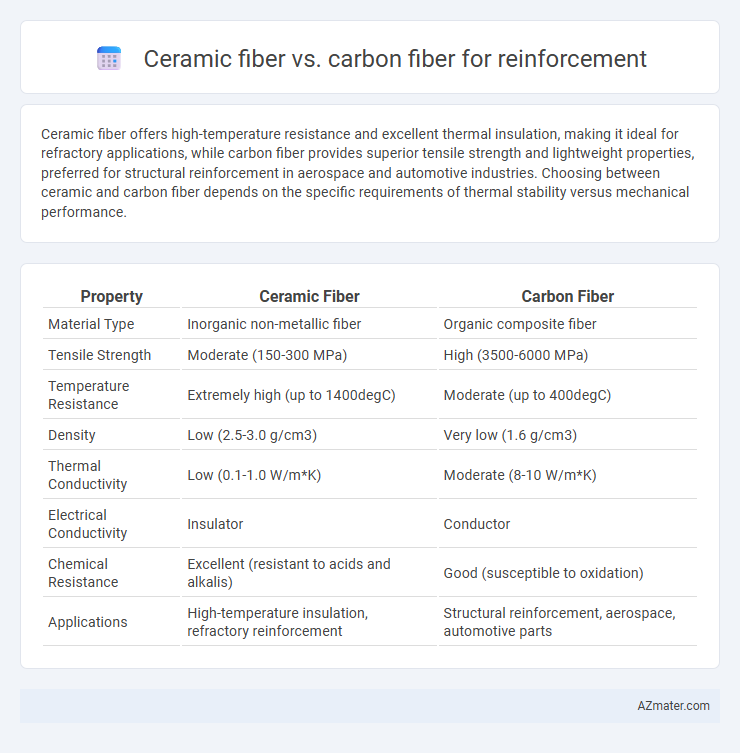Ceramic fiber offers high-temperature resistance and excellent thermal insulation, making it ideal for refractory applications, while carbon fiber provides superior tensile strength and lightweight properties, preferred for structural reinforcement in aerospace and automotive industries. Choosing between ceramic and carbon fiber depends on the specific requirements of thermal stability versus mechanical performance.
Table of Comparison
| Property | Ceramic Fiber | Carbon Fiber |
|---|---|---|
| Material Type | Inorganic non-metallic fiber | Organic composite fiber |
| Tensile Strength | Moderate (150-300 MPa) | High (3500-6000 MPa) |
| Temperature Resistance | Extremely high (up to 1400degC) | Moderate (up to 400degC) |
| Density | Low (2.5-3.0 g/cm3) | Very low (1.6 g/cm3) |
| Thermal Conductivity | Low (0.1-1.0 W/m*K) | Moderate (8-10 W/m*K) |
| Electrical Conductivity | Insulator | Conductor |
| Chemical Resistance | Excellent (resistant to acids and alkalis) | Good (susceptible to oxidation) |
| Applications | High-temperature insulation, refractory reinforcement | Structural reinforcement, aerospace, automotive parts |
Introduction to Reinforcement Materials
Ceramic fiber and carbon fiber are widely used reinforcement materials known for their high strength-to-weight ratios and thermal stability. Ceramic fiber excels in thermal insulation and resistance to extreme heat, making it ideal for high-temperature applications like furnaces and aerospace components. Carbon fiber offers superior tensile strength and stiffness, commonly employed in automotive, aerospace, and sporting goods to enhance structural performance without significant weight increase.
Overview: Ceramic Fiber and Carbon Fiber
Ceramic fiber offers exceptional heat resistance and electrical insulation, making it ideal for high-temperature reinforcement applications, while carbon fiber provides superior tensile strength and lightweight characteristics favored in structural composites. Ceramic fibers consist primarily of alumina and silica, delivering thermal stability up to 1,400degC, whereas carbon fibers are derived from polyacrylonitrile or pitch, enabling strength-to-weight ratios much higher than metals. Both fibers serve distinct reinforcement purposes: ceramic fibers excel in thermal protection and insulation, whereas carbon fibers dominate in mechanical reinforcement and durability in aerospace and automotive industries.
Material Composition and Structure
Ceramic fiber consists primarily of alumina and silica, offering high thermal stability and resistance to oxidation, while carbon fiber is composed of graphitic carbon atoms arranged in a crystalline structure, providing exceptional tensile strength and stiffness. The amorphous, porous microstructure of ceramic fibers allows for excellent insulation and heat resistance, whereas carbon fibers feature tightly packed carbon layers with strong covalent bonds, enhancing mechanical performance and electrical conductivity. Differences in material composition and internal structure directly influence their applications, with ceramic fibers favored for high-temperature environments and carbon fibers preferred for structural reinforcement in aerospace and automotive industries.
Mechanical Properties Comparison
Ceramic fiber exhibits high tensile strength, excellent thermal stability, and superior resistance to oxidation, making it ideal for high-temperature reinforcement applications. Carbon fiber offers exceptional stiffness, high tensile strength, and a low density, contributing to superior strength-to-weight ratios in mechanical reinforcement. While ceramic fiber excels in thermal and chemical resistance, carbon fiber is preferred for applications requiring lightweight, high-modulus mechanical components.
Thermal Resistance and Insulation
Ceramic fiber offers superior thermal resistance withstanding temperatures up to 1,650degC, making it ideal for high-temperature insulation applications such as furnace linings and heat shields. Carbon fiber exhibits lower thermal resistance, typically up to 600degC, but provides excellent mechanical strength and lightweight reinforcement in composite materials. For insulation purposes, ceramic fiber excels due to its low thermal conductivity and excellent heat retention, whereas carbon fiber is more effective for structural reinforcement under moderate thermal conditions.
Chemical Stability and Corrosion Resistance
Ceramic fiber offers superior chemical stability due to its inert oxide composition, making it highly resistant to acidic, alkaline, and high-temperature environments. Carbon fiber, while strong and lightweight, is more susceptible to corrosion and chemical degradation when exposed to oxidizing agents and moisture. For reinforcement applications requiring long-term chemical stability and corrosion resistance, ceramic fiber provides a more durable solution.
Weight-to-Strength Ratio
Carbon fiber outperforms ceramic fiber in weight-to-strength ratio, offering exceptional tensile strength while maintaining low density. Ceramic fiber, though heat-resistant and stable at high temperatures, tends to be heavier and less strong in tension compared to carbon fiber. For applications demanding lightweight and high-strength reinforcement, carbon fiber remains the preferred material due to its superior mechanical properties and efficiency.
Cost and Availability
Ceramic fiber offers a more cost-effective solution compared to carbon fiber, with prices significantly lower due to abundant raw materials and simpler manufacturing processes. Carbon fiber, while providing superior strength-to-weight ratio, comes at a premium cost and limited availability due to complex production and reliance on specialized precursor materials. The widespread availability of ceramic fiber makes it preferable for large-scale reinforcement projects where budget constraints are critical.
Typical Applications in Industry
Ceramic fiber is predominantly used in high-temperature insulation for furnaces, kilns, and thermal processing equipment due to its excellent heat resistance and low thermal conductivity. Carbon fiber finds extensive application in aerospace, automotive, and sports equipment industries where its superior strength-to-weight ratio and stiffness are critical for structural reinforcement. Both fibers enhance performance by improving durability and thermal stability, but ceramic fiber suits extreme temperature environments while carbon fiber excels in lightweight, high-strength composite materials.
Future Trends and Innovations
Ceramic fiber reinforcement is advancing with innovations in high-temperature resistance and thermal stability, making it ideal for aerospace and industrial applications demanding extreme heat tolerance. Carbon fiber reinforcement continues to evolve through enhanced tensile strength, lightweight design, and improved composite integration, driving future trends in automotive, sports equipment, and renewable energy sectors. Emerging hybrid composites combining ceramic and carbon fibers show promising potential for optimizing performance, durability, and multifunctional applications in next-generation materials engineering.

Infographic: Ceramic fiber vs Carbon fiber for Reinforcement
 azmater.com
azmater.com